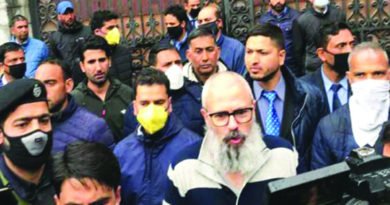Speaking up for the intellectual resurgence in non-cosmopolitan Bengal
How does a poet capture a boatman singing words to the gentle wind, a child bewildered by war, and a woman identified with rain? Bibhas Roy Chowdhury is a legendary poet who is known for the strength and diversity of his Bengali poetry. The translator into English, Kiriti Sengupta, has achieved an immense feat in bringing 60 poems into a 10th anniversary edition. Roy Chowdhury writes a nuanced Bangla, often focusing on rural Bengal, haunted by memories of Partition, and remains a highly private person. Poem Continuous: Reincarnated Expressions is a fortuitous title as it gestures towards the challenging act of translation and the desirable creativity of a refined translator.
One can offer a specific example by commenting on the exquisite poem, “In the Monsoon”, which begins with the lines, “The algae float in the song / of my tender age. / I wonder if the river / is nearing death.” Bengal’s dramatic kaal baishakhi and barsha defy any easy description—and here, the association with algae, which is a parasite, and water, which is an element associated with the final rites of ash immersion, are collocated to yield a magnificent spectrum. This short poem ends with a startling image: “In the song of my younger age / two blind come / across each other quite often”, packing a cryptic coding of “blind” relations among people. Is the Monsoon downpour from heaven a witness to social interludes, the maya or illusion of action? Such a poem is open to multiple interpretations, and I present mine as an example of the complexity of Roy Chowdhury’s writing and Kiriti’s translation.
If water, earth, and fire are the core elements defining human existence—as in the poems “I can Leave, but Why”, “Lunatic”, “The Lighthouse”, among others, do the poems take a philosophical stand in re-casting this eternal interdependence? Perhaps the answer is in the negative because Roy Chowdhury never repeats himself, nor does he preach. The book’s “Epilogue” comprises a significant interview between the author and translator. Kiriti asks: “Your poems mostly deal with agony and emotions…Why is this agony an essential component of your poems?” Roy Chowdhury answers obliquely, “Let my poetry capture the journey of the refugee boy from extreme distress to where I stand now. I have let my life ply behind the metaphors.
Metaphors are the greatest challenge to translators, and several poems build upon a key phrase or word. “The Poetry of a Hibiscus Flower” is a striking example, and if one reflects upon the lines, “The hibiscus lives in solitude as expected. / Lost people do exist, more or less in a similar way”, a plethora of cultural references will show up. Though a common flower, the hibiscus, called ‘joba’ in Bangla, is sacred to Maa Kali and offered in worship at the temple; Santhal women often wear it in their hair, and Jaba-Kusum is a popular cosmetic brand. These allusions float in the literary aura of the word. Roy Chowdhury astutely associates the hibiscus with a lost mother—perhaps pre-Partition Bengal—isolation, abandonment, yet hardy survival. Interestingly, the translator, Kiriti Sengupta, has independently written a poem, “Hibiscus”, with the lyrical lines: “I’ll bloom / like a hibiscus: / the blush will endorse / my bloodline” that I read in the Amethyst Review. My point is that metaphors are powerfully suggestive, and insightful poetry hints at a backstory through a key image and allows the reader to ponder over the consciousness it generates.
This respect for the author, the language, and the image is maintained remarkably in Poem Continuous. I proceed to address the rural subject in the poetry of Roy Chowdhury. “The Connector” purports to be a love poem and begins with the endearment phrase “love you.” Soon, it becomes apparent that the object of affection is not the usual beloved but a landscape: “When I said ‘we’ / I meant roadside flowers, village river / unknown birds as well /… we refused to hate but this morning / we told the metropolis to return / from one end of the connector” (40). The author’s love of the land is no pastoral idyll but endorses a preference for a nature-linked life that is possible only if the environment is protected and trees are not felled by rapacious city men. Choosing to live in Bongaon at the northern border of Bengal, the poet keeps alive the vibrant vocabulary and practices of ordinary people; at the same time, he often recalls the Bengal on the other side by invoking Jessore Road, the cross-border link. A futile dream expresses itself in “Bhatiali”: “In the core of my heart, I nurse my wounded soul carefully / union of the parted Bengal will aid in my recovery.”
The literary influences on Bibhas Roy Chowdhury are documented in tributes. Two poems are addressed to Rabindranath Tagore, one calling him “the source” , the other “to identify the tears” . In the translator’s note, Kiriti Sengupta has cited the poems and said, “Roy Chowdhury has shared no direct cause-effect relationship, but has wonderfully projected the implications of celebrating Tagore’s birthday among the Bengalis.” This may be elaborated to net in the resonant poems in the volume with themes that were dear to Gurudev (Tagore) — rural pathways, the seasons, the lush forests and the sincerity of rural dwellers. Joy Goswami is another influence on Roy Chowdhury, and in the poem dedicated to him, a few lines read:
“I burn, I receive light—
my fingers become exhausted!
Reader, are you aware
this is only my future and my present?”
Joy Goswami had said in an interview in Poetry International, “My poems, like my strokes, … can only console, but not cure.” Does Roy Chowdhury share a similar energy of the imagination yet despair about social change? Poem Continuous is dedicated to “the great Bengali poet Binoy Majumdar,” so a pertinent question from the translator to the author is why it is so. Roy Chowdhury says, “I learnt from him the real meaning of dedicating one’s life to poetry”. Readers of the translated text may not know much about Majumdar, who left Calcutta and turned into a recluse in a small place called Thakurnagar, but his powerful writing continued unabated despite ill health.
Much of this is leading into a concluding assessment of Poem Continuous: Reincarnated Expressions as a ground-breaking collection that is speaking up for the intellectual resurgence in non-cosmopolitan centres in Bengal, and I perceive in this a continuity from Tagore to Bibhas Roy Chowdhury. The supple quality of the Bengali language has never been dependent on city education, nor has the social experience of rural Bengal ever been a barrier to powerful literary output. Roy Chowdhury actually states his preference: “I think unrecognised and neglected poets who live in remote areas, or the poets located far away from the city chaos, write poetry that is deep and profound” . The bridge across the barriers of language and geography is the translator, and Kiriti Sengupta is to be heartily applauded for this mesmerising collection of Bibhas Roy Chowdhury’s poetry.
Source: The Daily Star




